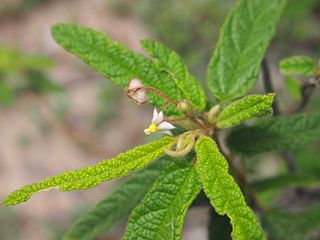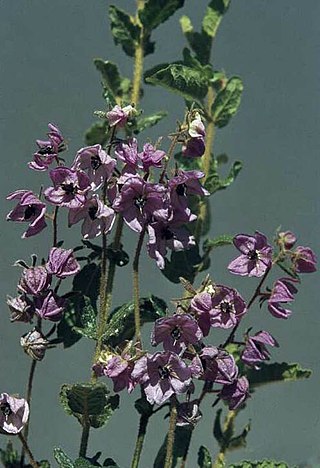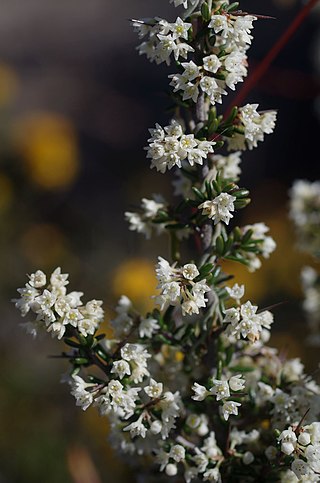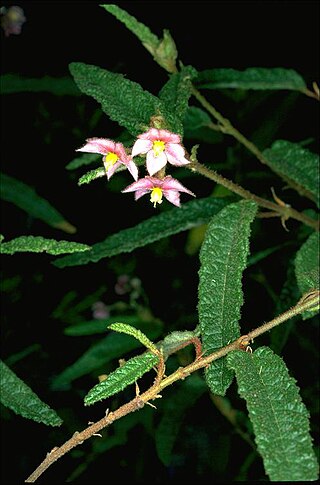
Seringia corollata is a species of flowering plant in the family Malvaceae and is endemic to north-eastern Australia. It is a small, low-growing shrub with hairy young branches, egg-shaped to lance-shaped leaves and mauve flowers arranged singly or in groups of up to 3.

Seringia hermanniifolia, commonly known as crinkle-leaved firebush, is a species of flowering plant in the mallow family and is endemic to the south-west of Western Australia. It is a low-growing or prostrate, suckering shrub with hairy new growth, hairy, wavy, oblong to egg-shaped leaves and mauve to bluish flowers arranged in groups of 3 to 8.

Seringia velutina, the velvet firebush, is a shrub in the Malvaceae family native to Western Australia.

Thomasia angustifolia, commonly known as narrow-leaved thomasia, is a species of flowering plant in the family Malvaceae and is endemic to the south-west of Western Australia. It has densely hairy young stems, narrowly oblong, wrinkled leaves and pinkish-purple, bell-shaped flowers.

Hibbertia subvaginata is a species of flowering plant in the family Dilleniaceae and is endemic to Western Australia. It is a small shrub that has yellow flowers with stamens arranged around three or four carpels.

Styphelia crassifolia is a species of flowering plant in the family Ericaceae and is endemic to [the south-west of Western Australia. It is an erect, bushy shrub that typically grows to a height of 60 cm (24 in). Its leaves are oblong, 4–9 mm (0.16–0.35 in) long on a short petiole, with 3 prominent ribs on the lower surface. One or two flowers are borne in leaf axils on a short peduncle with tiny bracts and bracteoles about half the length of the sepals. The sepals are about 1.6 mm (0.063 in) long and the petals are about 3.2 mm (0.13 in) long and joined at the base, the lobes about as long as the tube.

Rhadinothamnus euphemiae, is a slender, small, upright shrub with needle-shaped branchlets thickly covered with silvery scales and tubular greenish-purple tubular flowers throughout the year. It is endemic to the south coast of Western Australia.

Prostanthera canaliculata is a species of flowering plant in the family Lamiaceae and is endemic to the south-west of Western Australia. It is a small, erect shrub with hairy branchlets, narrow egg-shaped to narrow elliptical leaves and pale blue or pale violet to white flowers with no markings.

Commersonia craurophylla, commonly known as brittle leaved rulingia, is a species of flowering plant in the family Malvaceae and endemic to southern continental Australia. It is a dense, spreading shrub with crinkled, narrowly oblong to linear leaves, and white to cream-coloured flowers.

Styphelia flavescens is a species of flowering plant in the heath family Ericaceae and is endemic to the south-west of Western Australia. It is a shrub with oblong leaves and white, tube-shaped flowers that are densely bearded on the inside.

Thomasia cognata is a species of flowering plant in the family Malvaceae and is endemic to the south-west of Western Australia. It is a compact, multi-stemmed shrub with wrinkled, narrowly oblong to elliptic leaves and pale pink flowers.
Thomasia discolor is a species of flowering plant in the family Malvaceae and is endemic to the south-west of Western Australia. It is a small, compact shrub with hairy new growth, heart-shaped leaves with wavy, lobed edges, and pink flowers in crowded clusters.

Thomasia macrocalyx is a species of flowering plant in the family Malvaceae and is endemic to the south-west of Western Australia. It is an erect, bushy shrub with densely hairy new growth, egg-shaped leaves with a heart-shaped base and lobed or toothed edges, and groups of pale purple to mauve or white flowers.
Thomasia montana, commonly known as hill thomasia, is a species of flowering plant in the family Malvaceae and is endemic to the south-west of Western Australia. It is an upright to low, ground-covering shrub with hairy new growth, egg-shaped to broadly oblong leaves, sometimes with wavy or toothed edges, and pale purplish-pink to maroon flowers.

Cryptandra pungens is a species of flowering plant in the family Rhamnaceae and is endemic to the southwest of Western Australia. It is an erect, slender, spiny shrub that typically grows to a height of 0.2–1 m with many short branches ending with thin spines. Its leaves mostly in bundles and are 4–6 mm (0.16–0.24 in) long. The flowers are white, each on a pedicel 1–2 mm (0.039–0.079 in) long with minute, overlapping brown bracts at the base. The sepals are about 1.6 mm (0.063 in) long and joined at the base to form a broadly bell-shaped tube, with lobes half as long as the tube. Flowering occurs from May to November. The species was first formally described in 1845 by Ernst Gottlieb von Steudel in Lehmann's Plantae Preissianae from specimens collected in sandy forest near Perth. The specific epithet (pungens) means "ending in a sharp, hard point".
Thomasia rulingioides is a species of flowering plant in the family Malvaceae and is endemic to the south-west of Western Australia. It is an erect, open shrub with densely hairy new growth, narrowly oblong to narrowly egg-shaped leaves with wavy edges, and pink to purple flowers.

Commersonia magniflora is a species of flowering plant in the family Malvaceae and endemic to Australia. It is an erect shrub with wrinkled, narrowly oblong to elliptic or egg-shaped leaves, and deep pink flowers.

Androcalva melanopetala is a species of flowering plant in the family Malvaceae and is endemic to southern inland Western Australia. It is a sometimes prostrate shrub that has densely hairy new growth, egg-shaped to elliptic leaves with rounded teeth on the edges, and clusters of white or cream-coloured and pink to red flowers.
Seringia adenolasia is a species of flowering plant in the family Malvaceae and is endemic to northern Australia. It is a sticky, aromatic densely hairy shrub with egg-shaped to lance-shaped leaves sometimes with toothed edges, and creamy-pink or purple flowers, usually in groups of up to 5.

Seringia hookeriana is a species of flowering plant in the mallow family and is endemic to Queenland. It is a compact suckering shrub with rusty-hairy new growth, oblong leaves and deep purple flowers arranged in groups of 2 to 4.
















